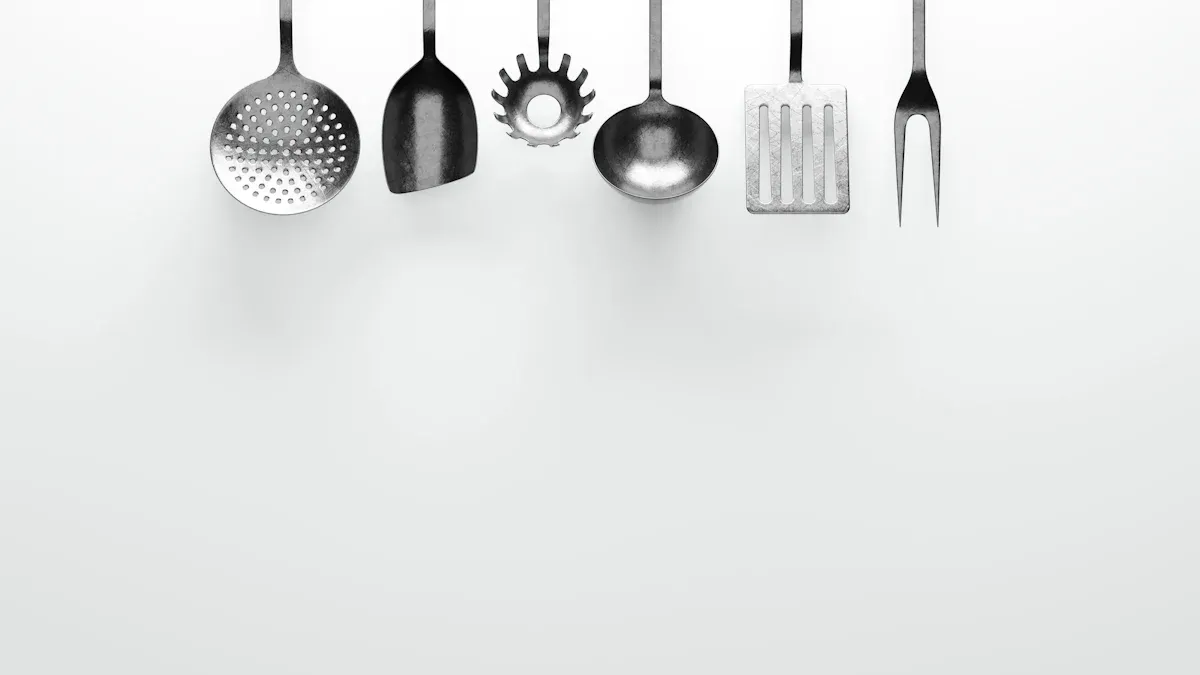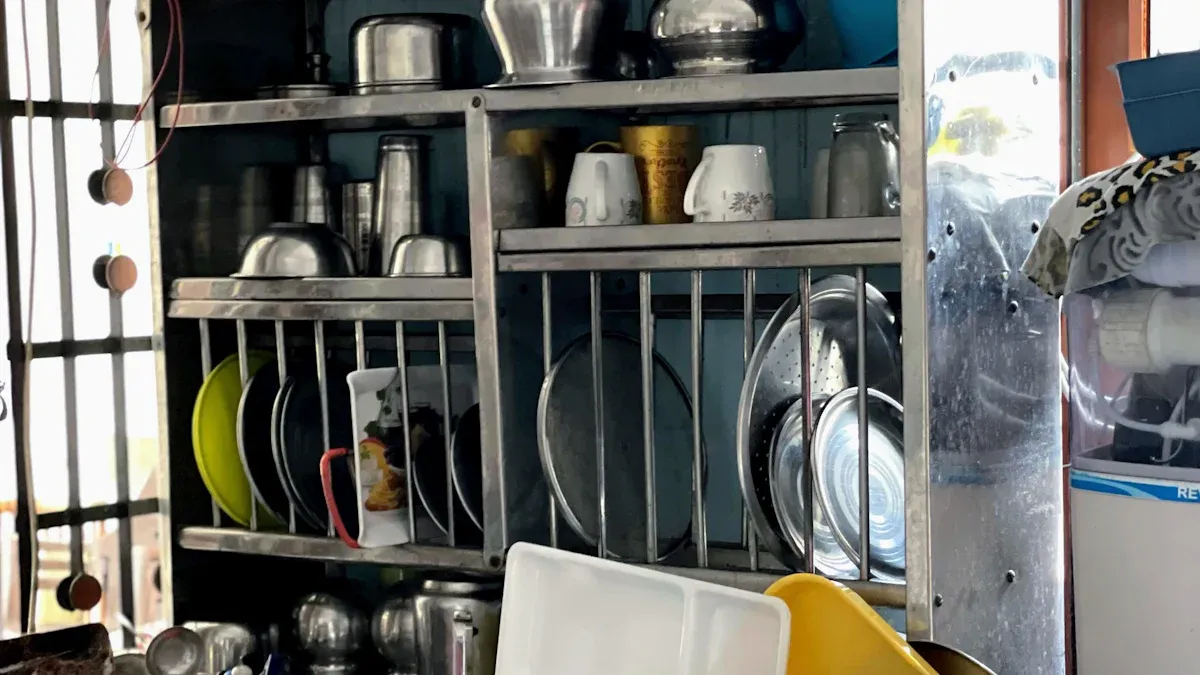
Stainless steel cookware offers durability and versatility, making it a favorite in many kitchens. However, food sticking often frustrates users. You can avoid this by learning how to use it properly. Master a few key techniques, and you’ll cook with confidence while enjoying the benefits of this reliable cookware.
Key Takeaways
- Preheat your stainless steel pan to prevent food from sticking. Use the water droplet test to check if it's ready.
- Use a thin layer of oil after preheating. This creates a barrier that helps food cook evenly without sticking.
- Care for your cookware by cleaning it properly and storing it correctly. This ensures its longevity and maintains its shine.
Why Stainless Steel Cookware is a Top ChoiceBenefits of Stainless Steel
Stainless steel cookware stands out for its durability and versatility. Unlike nonstick pans, it resists scratches and can handle high heat without damage. You can use it on any stovetop, including induction, making it a reliable choice for all types of cooking.
This cookware also offers excellent heat distribution. While it may take a little longer to heat up, it ensures even cooking, reducing the risk of hot spots that can burn food. Its non-reactive surface means you can cook acidic ingredients like tomatoes or vinegar without worrying about altering the flavor.
Another advantage is its longevity. With proper care, stainless steel cookware can last for decades. It doesn’t chip, rust, or warp, making it a sustainable option for your kitchen.
Tip: To get the most out of your stainless steel cookware, master a few key techniques like preheating and using oil effectively.
Why It’s Perfect for Modern Kitchens in 2025
In 2025, modern kitchens demand cookware that combines functionality with style. Stainless steel meets both needs. Its sleek, polished appearance complements contemporary kitchen designs, adding a professional touch to your space.
As more people prioritize sustainability, stainless steel cookware aligns with this trend. Its durability reduces waste, and many brands now offer eco-friendly manufacturing processes.
Technological advancements have also made stainless steel cookware more user-friendly. Many models now feature heat-resistant handles and multi-layered bases for improved performance. These innovations make it easier for you to cook like a pro.
Whether you’re searing, sautéing, or simmering, stainless steel cookware adapts to your needs. Its timeless appeal and practical benefits make it a must-have for any modern kitchen.
Master a Few Key Techniques for Cooking with Stainless Steel

Preheating and the Water Droplet Test
Preheating your stainless steel pan is essential for preventing food from sticking. Start by placing the pan on medium heat for a few minutes. To check if it’s ready, use the water droplet test. Add a small drop of water to the pan. If the water forms a single bead and glides across the surface, the pan is at the right temperature. If the water sizzles and evaporates immediately, the pan is too hot. Adjust the heat and try again. This simple test helps you master a few key techniques for cooking with stainless steel.
Using Oil Effectively to Prevent Sticking
Once the pan is preheated, add oil. Swirl it around to coat the surface evenly. Use just enough oil to create a thin layer. Too much oil can make your food greasy, while too little may cause sticking. Allow the oil to heat for a few seconds before adding your ingredients. Properly heated oil creates a barrier between the food and the pan, ensuring a smooth cooking experience.
Patience and Proper Timing When Cooking
Cooking with stainless steel requires patience. Avoid moving your food too soon. Let it cook undisturbed until it naturally releases from the pan. For example, when searing meat, wait until it forms a golden crust before flipping. Rushing can lead to sticking and uneven cooking. By mastering a few key techniques like timing and patience, you’ll achieve better results with stainless steel cookware.
Common Mistakes to AvoidOverheating the Pan
Overheating your stainless steel pan can lead to several problems. Excessive heat causes food to stick and burn, making cleanup more difficult. It can also discolor the pan, leaving unsightly marks that are hard to remove. To avoid this, always cook on medium or medium-high heat. Stainless steel retains heat well, so there’s no need to crank up the temperature. If you notice smoke or a burning smell, reduce the heat immediately. Keeping an eye on the heat level ensures better cooking results and protects your cookware.
Skipping Preheating or Using Too Much Oil
Skipping preheating is a common mistake that often leads to food sticking. Without proper preheating, the pan doesn’t create the nonstick effect you need. Always preheat your pan and use the water droplet test to check the temperature. Using too much oil is another issue. Excess oil can make your food greasy and unappetizing. Instead, aim for a thin, even layer of oil. Master a few key techniques like preheating and proper oil usage to improve your cooking experience.
Improper Cleaning Methods
Improper cleaning can damage your stainless steel cookware. Avoid using abrasive sponges or harsh cleaners, as they can scratch the surface. Instead, use warm water, mild dish soap, and a soft sponge. For stubborn stains, soak the pan or use a paste made from baking soda and water. Never put a hot pan under cold water, as this can cause warping. Proper cleaning keeps your cookware in excellent condition for years to come.
Caring for and Maintaining Stainless Steel CookwareCleaning Tips for Stubborn Stains
Stubborn stains can make your stainless steel cookware look dull. To tackle these, start by soaking the pan in warm water with mild dish soap. This loosens any burnt-on food. For tougher stains, create a paste using baking soda and water. Apply it to the stain and gently scrub with a soft sponge. Avoid steel wool or abrasive pads, as they can scratch the surface.
Tip: For discoloration caused by overheating, use a mixture of vinegar and water. Boil it in the pan, then rinse and dry thoroughly.
Regular cleaning keeps your cookware looking new and ensures it performs well.
Proper Storage to Prevent Scratches
Proper storage protects your stainless steel cookware from scratches. Stack pans carefully, placing a soft cloth or paper towel between each one. This prevents the surfaces from rubbing against each other. If you have limited space, consider hanging your pans on a rack. This not only saves space but also keeps them easily accessible.
Note: Avoid storing cookware with heavy items on top, as this can cause dents or warping over time.
Restoring Shine and Longevity
Over time, stainless steel can lose its shine. To restore it, polish your cookware with a stainless steel cleaner or a mixture of vinegar and water. Rub gently with a microfiber cloth to bring back the luster. Dry your pans immediately after washing to prevent water spots.
Emoji Reminder: ✨ A little care goes a long way in keeping your cookware shiny and long-lasting!
By following these steps, you’ll maintain the beauty and functionality of your stainless steel cookware for years to come.
Cooking with stainless steel cookware becomes easier when you apply the right techniques. Preheat your pan, use oil effectively, and avoid common mistakes. Care for your cookware to maintain its durability and shine. With these tips, you can confidently enjoy the versatility and long-lasting benefits of stainless steel in your kitchen.
Reminder: Practice makes perfect. Start small, and soon you’ll master cooking with stainless steel!
FAQ
How do I prevent food from sticking to stainless steel cookware?
- Preheat the pan properly.
- Use the water droplet test to check the temperature.
- Add a thin layer of oil before cooking.
Tip: Patience is key! Let food release naturally before flipping.
Can I use stainless steel cookware on induction stoves?
Yes, stainless steel works perfectly on induction stoves. Ensure your cookware has a magnetic base for compatibility. Most modern stainless steel pans meet this requirement.
What’s the best way to clean burnt food off stainless steel?
Soak the pan in warm, soapy water. Use a baking soda paste for stubborn spots. Avoid abrasive scrubbers to protect the surface.
Media Contact
Company Name: Zhejiang Cooker King Cooker Co., Ltd.
Email:Send Email
Phone: 86-579 87534901
Address:No. 599 Jiuding Road, Dongcheng Street
City: Yongkang
State: Zhejiang
Country: China
Website: https://www.cookerking.cn/
